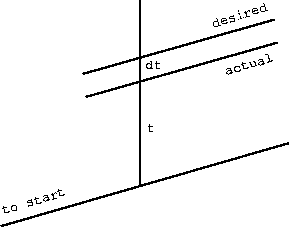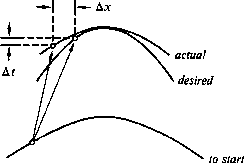A dipping reflector that is flat and regular can be analyzed in its entirety using the phase velocity concept. The group velocity concept is required only when more than one angle is simultaneously present. This simultaneity occurs with the point scatterer response. It also occurs when there is variable reflection amplitude along a dipping bed. The group velocity is needed because representation of either a curved event or an amplitude anomaly requires a range of plane-wave angles. Analogously, in time-series analysis the Fourier representation of an amplitude-modulated sinusoid requires a bandwidth of sinusoids.
Figure 14 depicts a smooth,
flat, dipping bed that has been undermigrated
because the ![]() defined
by some rational square-root approximation
or some numerical approximation
did not match the correct square-root value of kz.
defined
by some rational square-root approximation
or some numerical approximation
did not match the correct square-root value of kz.
|
undermig
Figure 14 Undermigrated dipping reflector. |  |
The error in Figure 14 is entirely a time-shift error. Since the reflection coefficient is constant along the reflector, no lateral shift error can be recognized. The time error may be theoretically determined by
| |
(19) |
Next, the error in the collapse of a hyperbola will be determined. Figure 70 depicts the downward continuation of a hyperbola. For clarity, the downward continuation was not taken all the way to the focus. Select a ray of some Snell's parameter p = dt/dx by choosing some slope p. Imagine a tangent line segment of slope p to each of the hyperboloids. If there were a little amplitude anomaly where the slope is p, you would be able to identify it on each of the hyperboloids.
|
errcollapse
Figure 15 Error of hyperbola collapse. Note that the actual curve is above the desired curve, but the actual point is below the desired point. |  |
In Figure 7 the amount of time moved is too little;
likewise, the lateral distance moved is too small.
In practice,
errors of the 15![]() equation with
equation with ![]() are sometimes compensated
by an increase in either z or v of about 6%.
The amounts of the errors may be calculated from
are sometimes compensated
by an increase in either z or v of about 6%.
The amounts of the errors may be calculated from
 |
(20) | |
| (21) |
where kz is taken to be a function of ![]() and
kx. It turns out that for the 15
and
kx. It turns out that for the 15![]() equation, about a
half-percent group velocity error occurs at 20
equation, about a
half-percent group velocity error occurs at 20![]() .Thus the group velocity error is generally worse than the phase
velocity error.
.Thus the group velocity error is generally worse than the phase
velocity error.